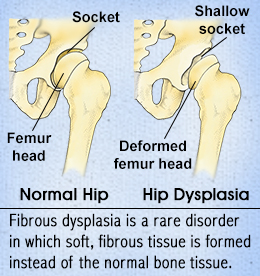Fibrous dysplasia is a condition that disturbs the process of bone regeneration, with normal bone being replaced by abnormal fibrous tissue, leading to pain, weakening, and fracture of the affected bone.

Fibrous dysplasia is a disorder of the bone, wherein, abnormal, fibrous tissue develops in a part of a bone instead of the normal bone tissue. This disorder starts sometime during the development of the fetus. Although it starts before birth, it usually goes undetected until later, during childhood, or adolescence, or sometimes, even adulthood. As the affected bone continues to grow, the fibrous tissue, which is weaker, enlarges, thus causing the entire bone to become weak, brittle, painful, and even deformed.
The condition can affect any bone in the body, and several bones may be affected at a time. When a number of bones are affected, it is often observed that they are all located on one side of the body. Nevertheless, the condition does not spread from one affected bone to another. Some of the bones that are usually affected are: the bones in the face, skull, ribs, humerus (bone in the upper arm), pelvis, femur (thigh bone), tibia (shinbone), and less often, the spinal vertebrae.
Causes
The disease develops in the fetal stage, and its occurrence has been associated with the mutation of a gene that affects the cells that make bones. Although, it is still not known exactly what causes this mutation, it is known that it is not a hereditary disease.
Bones renew themselves continuously even after one stops growing. In the renewal process, particular types of bone cells, known as osteoclasts, break down the bone, or reabsorb bone minerals, whereas, other types of bone cells, known as osteoblasts, build it up again. When dysplasia affects a bone, this process is disrupted, resulting in old bone breaking down faster than the rate at which it is built. In order to cope with this, the normal bone tissue gets replaced by the soft and weak fibrous tissue.
Signs and Symptoms
Although the symptoms of fibrous dysplasia may be experienced differently by different people, given below are some of the common ones:
- Pain in the affected bone due to the expansion of the fibrous tissue
- Deformity in the bone
- Fractures of the affected bone
- Scoliosis, which is an abnormal lateral curvature of the spinal column, resulting in the person seeming to lean towards one side
- A tottering walk
As is quite evident, these symptoms can also occur in other types of bone disorders, hence, a doctor should be consulted in order to confirm the diagnosis.
Treatment
As of now, there is no cure for this bone condition, and hence, the treatment basically involves relieving the symptoms presented by the affected person.
If there are no symptoms in a person affected with fibrous dysplasia, the condition is observed, with X-rays taken periodically, with no further treatment, if it is found that the condition is not progressing. Sometimes braces may be used in order to prevent the bone from fracturing, although they have not been able to prevent the bone from getting deformed.
However, if the condition does progress, it is usually treated by medication and surgery.
Medications: Medications known as bisphosphonates, such as, alendronate and pamidronate, help in slowing the breakdown of bone, maintaining bone mass, and increasing the density of the bone in the hip and spine, thus lowering the chances of fractures. While these medications are usually used in adults for treating osteoporosis and increasing the density of bones, they also help in reducing the pain that accompanies fibrous dysplasia, and sometimes may even help in improving the formation of bone.
Although not much is known about how bisphosphonates affect adolescents and children, according to some studies it may help in relieving their pain.
Surgery: Surgery may include the excision of the affected area of the bone. This may be followed by bone grafting, wherein, a healthy bone from another area of the body is transplanted into the area affected by fibrous dysplasia. However, over a period, the grafted bone too, is absorbed, and replaced with fibrous tissue.
Also, the affected bone may be stabilized with the help of a rod placed inside the bone, along with screws and plates, which can be useful in fixing a deformity or fracture, or, also to prevent the bone from breaking.
Disclaimer: This Buzzle article is for informative purposes only, and should not be used as a substitute for professional medical advice.


 Fibrous dysplasia is a disorder of the bone, wherein, abnormal, fibrous tissue develops in a part of a bone instead of the normal bone tissue. This disorder starts sometime during the development of the fetus. Although it starts before birth, it usually goes undetected until later, during childhood, or adolescence, or sometimes, even adulthood. As the affected bone continues to grow, the fibrous tissue, which is weaker, enlarges, thus causing the entire bone to become weak, brittle, painful, and even deformed.
Fibrous dysplasia is a disorder of the bone, wherein, abnormal, fibrous tissue develops in a part of a bone instead of the normal bone tissue. This disorder starts sometime during the development of the fetus. Although it starts before birth, it usually goes undetected until later, during childhood, or adolescence, or sometimes, even adulthood. As the affected bone continues to grow, the fibrous tissue, which is weaker, enlarges, thus causing the entire bone to become weak, brittle, painful, and even deformed.